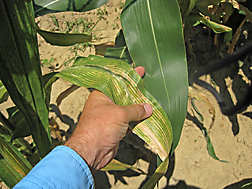Washington, DC, USA
September 13, 2010
 A new method for testing gene function in maize plants has been created by U.S. Department of Agriculture (USDA) scientists and university cooperators.
A new method for testing gene function in maize plants has been created by U.S. Department of Agriculture (USDA) scientists and university cooperators.
Peter Balint-Kurti, a geneticist with the USDA's Agricultural Research Service (ARS) at the agency's Plant Science Research Unit in Raleigh, N.C., teamed up with colleagues Guri Johal and Cliff Weil at Purdue University to create MAGIC, an acronym that stands for "mutant-assisted gene identification and characterization." ARS is the USDA's principal intramural scientific research agency.
MAGIC is a gene-centered approach that uses mutant genes or other genetic variants controlling a trait of interest as "reporters" to identify novel genes and variants for that trait. This method offers researchers a new way of sifting through the large amount of natural genetic variation to identify and map versions of genes important for the control of specific, agriculturally useful traits.
Balint-Kurti and colleagues recently demonstrated MAGIC's usefulness when examining hypersensitive response in maize. Hypersensitive response is a defense mechanism used by all plants in which one or a few cells surrounding the site of a pathogen attack kill themselves to prevent further spread of the pathogen.
The research team experimented with mutant gene Rp1-D21, which causes hypersensitive-response lesions to form spontaneously all over a plant regardless of whether a pathogen is present. The researchers crossed a plant containing Rp1-D21 with two popular maize inbred lines, one of which partially suppresses hypersensitive response and the other which partially enhances it, to identify a genomic location involved in the pathway controlling the start or local spread of hypersensitive response.
The scientists are currently conducting more hypersensitive response studies. Funded by the National Science Foundation, the scientists are now using MAGIC to identify other genomic regions responsible for hypersensitive response.
This research supports the USDA priority of promoting international food security.
Details about MAGIC were recently published in the scientific journals Crop Science and Genetics.
Read more about this and other research to improve corn in the September 2010 issue of Agricultural Research magazine.
Photo: Two leaves from sibling plants. The plant on the left has the Rp1-D21 gene, which causes hypersensitive response (the mottled yellow appearance). The plant on the right doesn’t have this gene. Photo by Peter Balint-Kurti.
Una nueva manera de probar la función de genes en las plantas de maíz
ientíficos del Servicio de Investigación Agrícola (ARS) y sus colaboradores universitarios han creado una nueva manera de probar la función de genes en las plantas de maíz.
Peter Balint-Kurti, quien es genetista con la Unidad de Investigación de la Ciencia de Plantas mantenida por el ARS en Raleigh, Carolina del Norte, colaboró con científicos Guri Johal y Cliff Weil de la Universidad de Purdue en crear el método llamado 'MAGIC' ("magia"), una sigla que significa en inglés 'identificación y caracterización de genes asistida por mutantes'. ARS es la agencia principal de investigaciones científicas del Departamento de Agricultura de EE.UU. (USDA por sus siglas en inglés).
MAGIC es un enfoque que usa los genes mutantes y otros variantes genéticos que controlan rasgos de interés como "reporteros" para identificar los genes y variantes novedosos relacionados con ese rasgo. Este método ofrece a los investigadores una nueva manera de examinar cuidadosamente la cantidad grande de variación genética natural para identificar y mapear versiones de los genes que tienen un papel importante en controlar rasgos específicos y útiles en la agricultura.
Balint-Kurti y sus colegas recientemente demostraron la utilidad de MAGIC en la examinación de la respuesta hipersensible en las plantas de maíz. La respuesta hipersensible es un mecanismo de defensa utilizado por plantas en el cual una o algunas células rodeando el sito de un ataque por un patógeno se matan ellas mismas para prevenir más propagación del patógeno.
Los investigadores experimentaron con el gen mutante Rp1-D21, el cual causa la formación de las lesiones de la respuesta hipersensible en todas partes de la planta sin tener en cuenta si el patógeno en realidad está presente. Los investigadores cruzaron una planta que contuvo el gen Rp1-D21 con dos líneas populares de maíz endogámica. Una de las dos líneas contuvo la capacidad de parcialmente suprimir la respuesta hipersensible, y otra parcialmente aumenta esa respuesta. Esto ayudó a los investigadores a identificar un sitio genómico involucrado en el mecanismo que controla el comienzo o la propagación local de la respuesta hipersensible.
Los investigadores actualmente están realizando más estudios sobre la respuesta hipersensible. Con fondos provistos por la Fundación Nacional de la Ciencia, los investigadores están utilizando MAGIC para identificar otras regiones genómicas que tienen un papel en la respuesta hipersensible.
Estos estudios apoyan la prioridad del USDA de promover la seguridad alimentaria internacional.
Detalles sobre MAGIC han sido publicados en las revistas científicas 'Crop Science' (Ciencia de Cultivos) y 'Genetics' (Genética).
Lea más sobre esta investigación y otros estudios relacionados con el mejoramiento del maíz en la revista 'Agricultural Research' de septiembre del 2010.